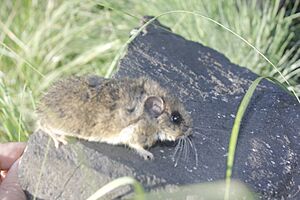Mexican volcano mouse facts for kids
Quick facts for kids Mexican volcano mouseTemporal range: Pleistocene – Recent
|
|
|---|---|
 |
|
| Conservation status | |
| Scientific classification | |
| Genus: |
Neotomodon
|
| Species: |
alstoni
|
The Mexican volcano mouse (Neotomodon alstoni) is a small rodent that lives in the high mountains of central Mexico. It is found only in a specific area called the Trans-Mexican Volcanic Belt.
Contents
About the Mexican Volcano Mouse
The Mexican volcano mouse is a unique type of mouse. It was first described by a scientist named Clinton Hart Merriam in 1898. For a while, scientists thought it might be part of the Peromyscus group, also known as deer mice. However, it was later moved back to its own special group, Neotomodon.
Where the Mouse Lives
This mouse lives only in the high, cool areas of the Trans-Mexican Volcanic Belt in Central Mexico. It likes places with good drainage where it can dig simple burrows. Sometimes, it even makes its home under big rocks. Scientists have not found any old fossils of this mouse yet.
What the Mouse Looks Like
The Mexican volcano mouse is a medium-sized mouse. It has soft fur that is grayish-brown on its back and white underneath. Its ears are wide and don't have much fur. It has a short tail that is dark on top and light underneath.
It has relatively large eyes and ears. Its tail is a bit shorter than its body. The mouse looks very similar to a deer mouse. However, scientists can tell them apart by looking closely at their skulls and teeth. For example, they check the shape of the skull and the details of the molars (back teeth). Male and female mice look the same.
Reproduction and Family Life
Mexican volcano mice usually have babies between June and September. A mother mouse can have two or three litters (groups of babies) each year. Each litter typically has about three young mice.
When these mice are kept in a safe environment, both parents help take care of the babies. This suggests that they might stay together as a pair in the wild. Scientists are still learning about other parts of their life, like how old they are when they first have babies. Studies show that when both parents are present, the young mice have a much better chance of surviving and growing.


